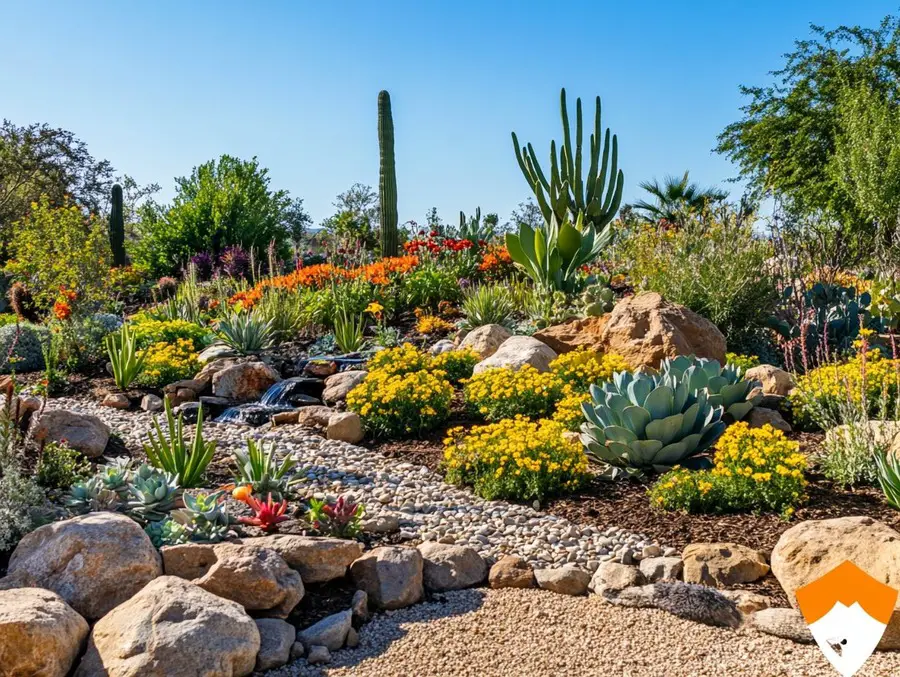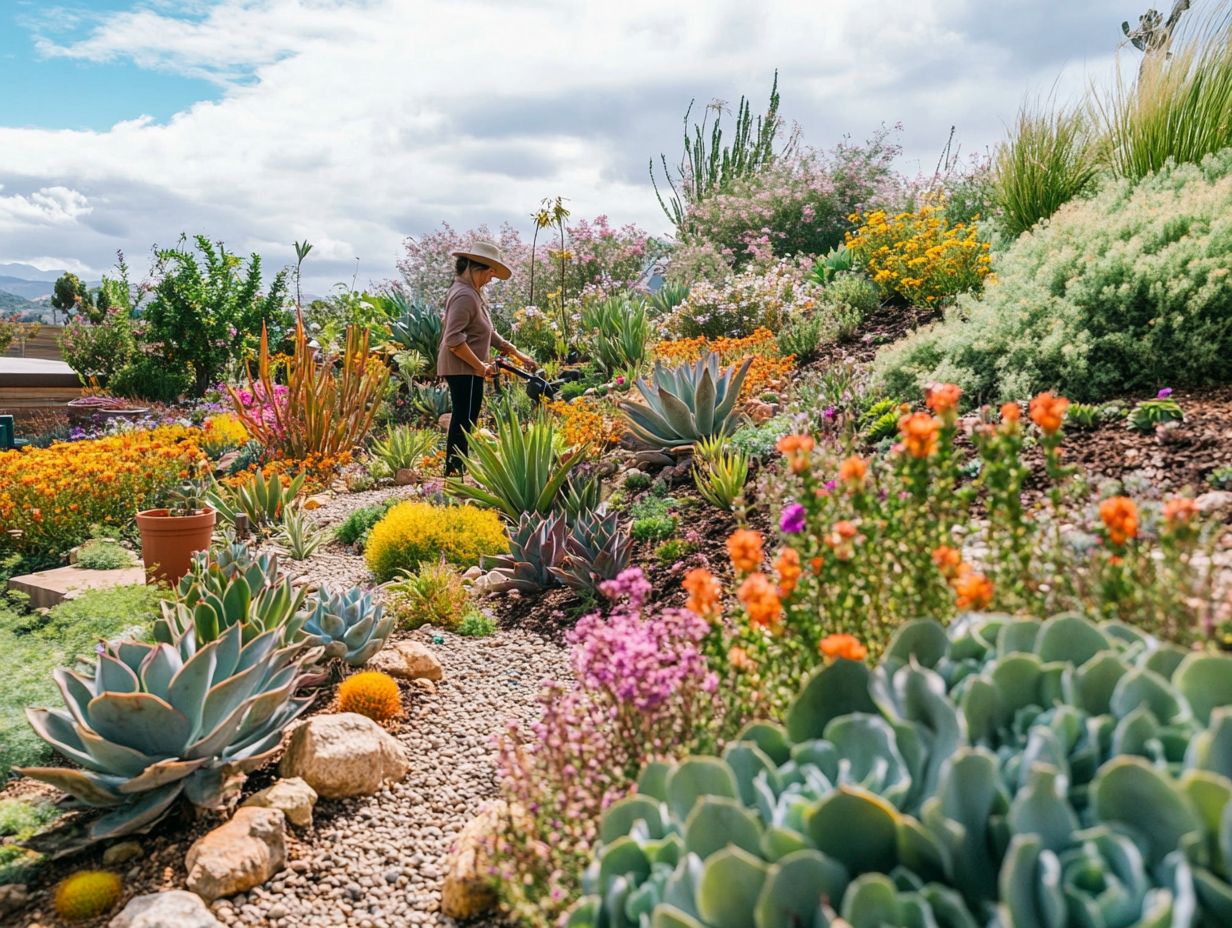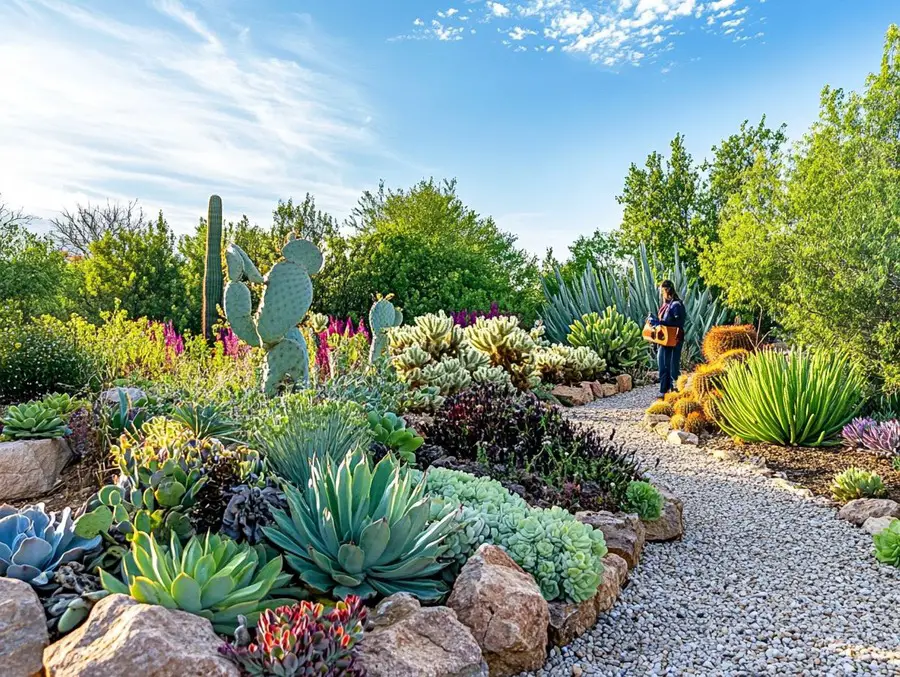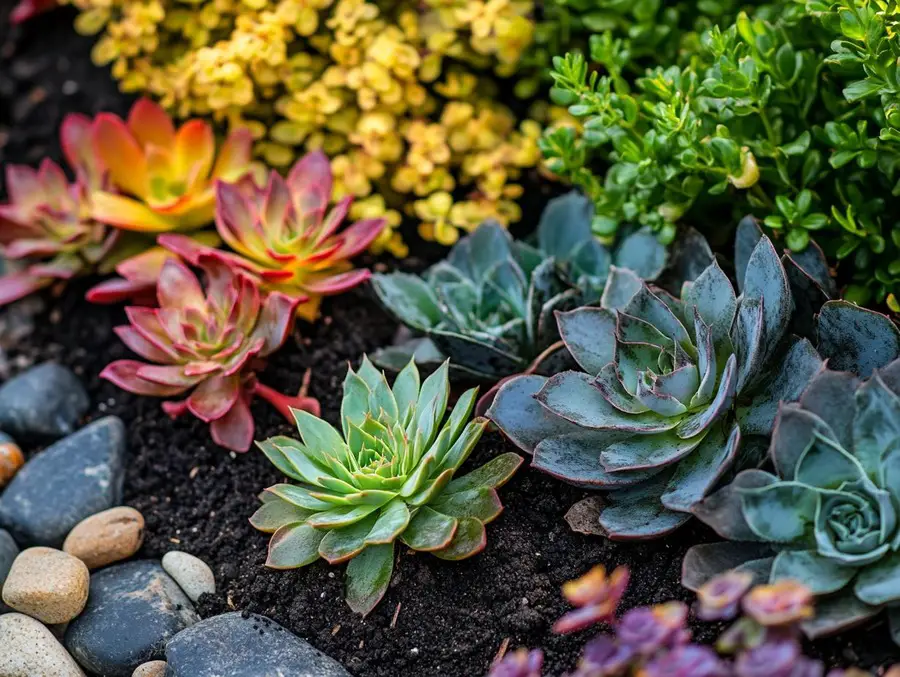We use affiliate links. If you purchase something using one of these links, we may receive compensation or commission.
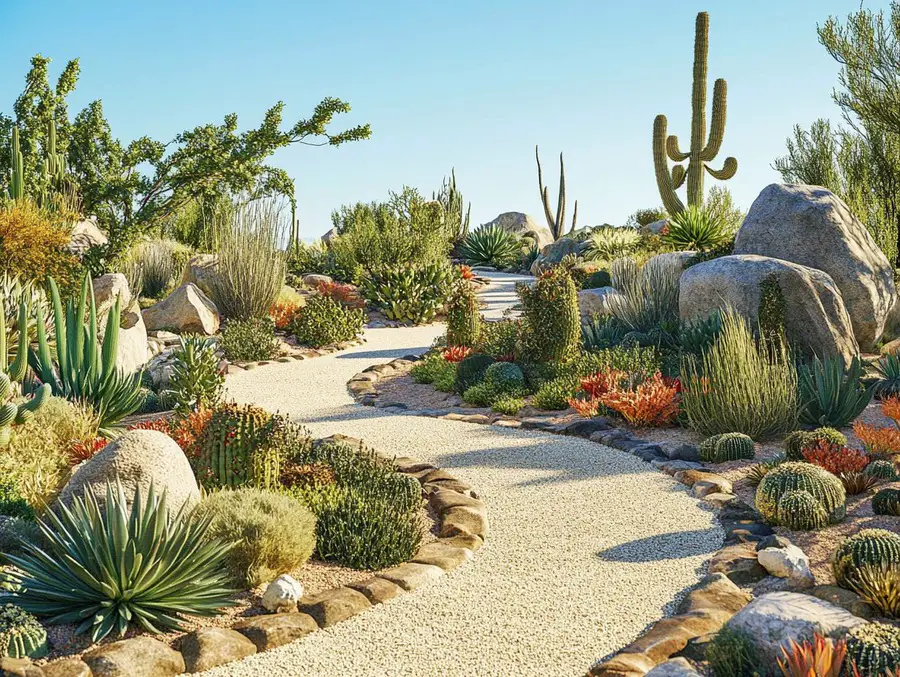
Designing a Simple Xeriscape is a sustainable landscaping approach that focuses on water conservation and uses drought-tolerant plants to create beautiful, low-maintenance outdoor spaces.
This method brings a ton of benefits, both for the environment and your wallet, and it involves some key steps to design your own xeriscape.
You’ll want to learn how to pick the right plants, set up an efficient irrigation system, and maintain your landscape effectively.
With the right tips, you can ensure your xeriscape thrives while avoiding common pitfalls.
So, get ready to turn your yard into a stunning oasis that conserves water and boosts your home’s beauty!
What is Xeriscaping?

Xeriscaping is a fantastic landscaping method that helps you create beautiful outdoor spaces while promoting water conservation with drought-tolerant plants and sustainable gardening practices.
It’s especially useful if you’re in arid or semi-arid regions, where water scarcity can really throw a wrench in your gardening plans.
By using xeriscaping principles, you can design a landscape that supports native ecosystems, boosts biodiversity, and minimizes your environmental impact.
Some key components to consider are preparing your soil, using efficient irrigation techniques, and choosing climate-appropriate plants that thrive with minimal water.
Not only does xeriscaping tackle the important issue of water conservation, but it also adds a unique aesthetic charm to your garden.
By incorporating native plants, you can cultivate vibrant landscapes that showcase the natural beauty of your surroundings while attracting local wildlife.
This style of ecological design encourages you to create harmonious outdoor spaces that need less maintenance and resources.
Plus, xeriscaping encourages the use of mulch, stones, and other materials that improve soil quality and keep moisture locked in, helping your garden thrive.
Embracing xeriscaping is a great step toward sustainable living and offers a visually appealing solution to modern landscaping challenges.
What is xeriscaping? A beginner’s guide to drought-tolerant landscaping
Benefits of Xeriscaping
Xeriscaping offers a lot more than just good looks. It plays a big role in water conservation and sustainable landscaping.
By choosing this method, you can cut down on water usage, reduce maintenance costs, boost biodiversity, and lessen the environmental impact that comes with traditional landscaping.
When you create xeric gardens filled with drought-tolerant plants, you’re not just making your yard pretty.
You’re also providing a vibrant habitat for wildlife and promoting ecological sustainability in your outdoor spaces.
Also, xeriscaping techniques help improve soil health and build resilience against the effects of climate change, making it a savvy choice for anyone who cares about the environment.
Environmental and Financial Benefits
You’ll find that both environmental and financial benefits are pretty significant when you practice xeriscaping.
This approach helps you cut down on excessive irrigation and keeps those maintenance costs in check.
By using water-efficient design strategies, like eco-friendly irrigation techniques and native plants, you’re not just conserving valuable water resources.
You’re also lowering your overall gardening expenses.
And, by minimizing your reliance on chemical fertilizers and pesticides through sustainable gardening practices, you can improve soil health and contribute to a healthier ecosystem, making your landscaping efforts even more impactful.
On top of that, xeriscaping promotes biodiversity by creating habitats for local wildlife, which encourages beneficial pollinators to thrive in your garden.
This symbiotic relationship not only supports various species but also cuts down on the need for chemical inputs since healthier ecosystems naturally fend off pests.
From a financial standpoint, the initial investment in drought-resistant plants and innovative landscaping techniques really pays off over time.
You’ll see lower water bills and reduced labor costs.
Ultimately, embracing these sustainable practices helps you become a better environmental steward while also bringing long-term savings that any homeowner can appreciate.
Planning Your Xeriscape Design
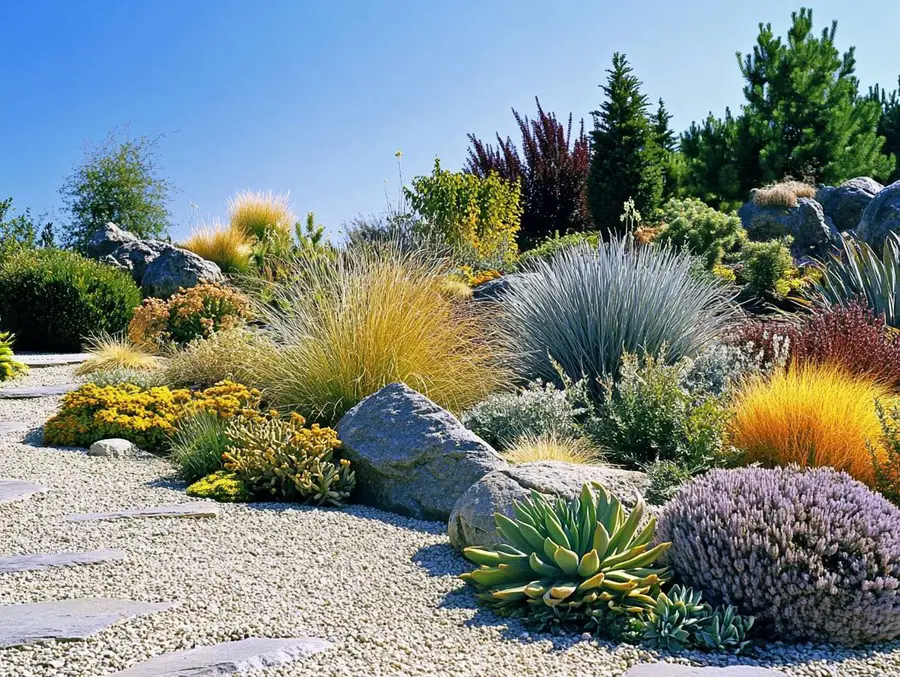
When you’re planning your xeriscape design, it’s all about giving some thought to your landscape’s unique features and your gardening needs.
By using principles of ecological landscaping, you can create a layout that not only boosts your garden’s functionality but also adds visual flair.
Start by checking out your outdoor space. Take note of sun exposure, soil type, and any existing plants to help you choose the right ones.
Think about how elements like hardscaping, rock gardens, and native shrubs can come together to create a cohesive design that supports biodiversity and invites those helpful pollinators in.
Assessing Your Landscape and Needs
Assessing your landscape and needs is a key step in the xeriscaping process.
By understanding the unique characteristics of your outdoor space, you’ll be able to make smarter choices about plant selection and design.
Start by evaluating your garden zones and pinpointing any microclimates that might affect plant growth—like areas that are particularly shady or sunny.
Soil preparation is also super important; you want to ensure you have proper drainage and healthy topsoil to support your drought-tolerant plants and native ecosystems.
To do this assessment effectively, think about testing your soil for pH and nutrient levels since these factors can really influence your plant choices.
Monitor how water drains in different sections of your landscape because poor drainage can stifle the growth of certain species.
Also, take note of wind patterns and nearby structures; this will help you spot sheltered areas and spots that might need some protective landscaping features.
By understanding these elements, you can create a thriving, efficient landscape that not only conserves water but also boosts the beauty of your outdoor space.
Choosing Drought-Tolerant Plants
Choosing the right drought-tolerant plants is key to making your xeriscape flourish while using minimal water.
When you go for native plants and other climate-friendly options, you’re boosting plant resilience and adding a touch of biodiversity to your garden.
By taking the time to select a mix of ornamental grasses, ground covers, and native shrubs, you can create a beautiful landscape that not only looks great but also requires less maintenance and supports local wildlife.
Best Plant Options for Xeriscaping

When you’re picking the best plants for xeriscaping, think about incorporating a diverse range of drought-tolerant species.
Ornamental grasses and native shrubs that thrive in your local environment are great options.
These plants not only give your garden some lovely texture and seasonal interest but also support local pollinators, boosting the ecological value of your space.
By mixing different plant types in your xeric garden, you can promote biodiversity while creating a sustainable landscape that needs minimal irrigation.
Choosing perennials that require less water means you’ll spend less time on maintenance and more time enjoying a vibrant garden throughout the seasons.
For instance, succulents and native wildflowers can add unique colors and shapes to your landscape while easily adapting to various garden zones.
Selecting plants like lavender and agave not only enhances the visual appeal but also attracts beneficial insects, which helps create a healthy ecosystem.
By embracing xeriscaping principles, you can strike a perfect balance between beauty and sustainability, leading to a thriving, resilient garden environment.
Creating a Water-Efficient Irrigation System
Creating a water-efficient irrigation system is key to xeriscaping, helping your garden stay healthy while conserving precious water resources.
By designing your irrigation systems with sustainable gardening practices in mind, you can optimize water usage and boost soil health.
Techniques like drip irrigation, rainwater harvesting, and smart timing in your watering schedules can really amp up your plants’ performance while minimizing waste.
Types of Irrigation Systems
There are plenty of irrigation systems out there that can help you save water and make your xeriscape more efficient.
Drip irrigation is one of your best bets; it delivers water straight to the plant roots, which means less evaporation and more hydration where it counts.
You might also want to consider rainwater harvesting systems, which capture and store rainwater for later use.
Definitely a sustainable way to keep your garden thriving.
Of course, you can still make traditional methods like soaker hoses and sprinklers work for you by optimizing them for reduced water use.
Alongside these popular choices, sub-surface irrigation is gaining traction.
This method uses buried tubing to deliver water just below the soil surface, cutting down on evaporation and encouraging those roots to dig deeper.
If you really want to take it up a notch, smart irrigation systems with moisture sensors can adjust your watering schedule automatically based on real-time conditions.
Talk about efficiency!
By implementing these techniques, you conserve water, and you also support the long-term health of your xeriscaped landscape.
This way, your plants can flourish in arid conditions without wasting valuable resources.
Understanding how each system works and what benefits it offers will help you make the right choice for your specific plant needs.
Maintaining Your Xeriscape
Maintaining your xeriscape is vital for long-term success, helping you enjoy a flourishing garden that saves water and promotes sustainable gardening practices.
Engaging in regular maintenance activities, like applying organic mulch, checking your soil health, and fine-tuning your irrigation system, can really boost your plants’ resilience and overall garden performance.
By staying in the loop about best practices and diving into garden education, you can keep your xeriscape vibrant and ecologically balanced, making your outdoor space a true oasis.
Tips for Long-Term Success
To achieve long-term success with your xeriscape, it’s crucial to incorporate effective maintenance strategies and thoughtful garden planning right from the start.
By doing this, you’ll create an environment where native plants can thrive, which means you won’t have to rely on excessive watering or chemical fertilizers.
Think about creating microclimates in your garden; positioning taller plants to provide shade for smaller ones can really boost their growth and help retain moisture.
Don’t forget about mulching around your plants. It’s a great way to suppress weeds and cut down on evaporation, making your watering efforts way more efficient.
Encouraging biodiversity by adding a variety of plant species can also improve your garden’s resilience against pests and diseases, leading to a healthier and more sustainable landscape overall.
Regular upkeep, like pruning and keeping an eye on soil health, will keep your garden vibrant and functional year after year.
Common Mistakes to Avoid
Avoiding common mistakes in xeriscaping can really boost your garden’s success and help you create a thriving, sustainable landscape.
One common error you might run into is picking the wrong plants, choosing species that just aren’t suited to your local climate or soil conditions.
Plus, if you mess up your irrigation, like over-watering or using ineffective systems, it can really hurt your plants’ resilience and sabotage your water conservation goals.
So, staying on top of these things can make all the difference in your xeriscaping journey!
Key Design and Maintenance Mistakes
Key design and maintenance mistakes can really put a damper on your xeriscaping success.
From poor layout choices to skimping on care routines, every little detail counts.
For example, if you don’t group plants with similar water needs, you could end up with inefficient irrigation that wastes water and makes your plants less resilient.
And if you neglect regular maintenance tasks like mulching and soil amendments, you might compromise the health of your drought-tolerant plants, which really undermines your sustainable gardening goals.
Improperly placing trees and shrubs can also create unnecessary shade for your sun-loving plants, stunting their growth and vitality.
You also need to choose your materials wisely. Using landscape fabrics that trap moisture instead of allowing for proper drainage could lead to root rot and other nasty issues.
Regularly keeping an eye on your landscape for pests and diseases is key to maintaining plant health.
And don’t forget to utilize local resources when selecting plants to ensure they’re well-suited for your region, promoting long-term success.
By establishing a thoughtful design and sticking to solid maintenance practices, you’ll create a thriving xeriscape that truly reflects the principles of water-efficient gardening.
Frequently Asked Questions
What is a xeriscape?
A xeriscape is a type of landscaping that uses drought-resistant plants and methods to conserve water.
It is designed to reduce the need for irrigation and maintenance, making it an eco-friendly and cost-effective option for landscaping.
Why should I consider designing a simple xeriscape?
A simple xeriscape offers many benefits, such as reducing water usage, saving money on maintenance, and creating a beautiful and sustainable landscape.
It also requires less time and effort to maintain, making it a low-maintenance option for busy homeowners.
What are the key elements of a simple xeriscape design?
The main elements of a simple xeriscape design include choosing drought-resistant plants, incorporating hardscape features such as mulch and gravel, implementing efficient irrigation methods, and planning for proper drainage.
Do I need to live in a dry climate to have a xeriscape?
No, xeriscaping can be done in any climate. While it is most commonly used in dry regions, the principles of xeriscaping can be applied to any landscape to make it more water-efficient and sustainable.
Is designing a simple xeriscape expensive?
The cost of designing a xeriscape can vary depending on the size and complexity of the project.
However, in the long run, a xeriscape can save you money on water and maintenance costs, making it a cost-effective option for landscaping.
Can I still have a beautiful landscape with a simple xeriscape design?
Absolutely! Xeriscaping doesn’t mean sacrificing beauty.
By carefully choosing drought-resistant plants and incorporating hardscape features, you can create a stunning and unique landscape that is also environmentally friendly and low-maintenance.
Xeriscape Garden Design & Layout: Easy Water-Wise Beauty – Urban Gardening Ideas
Related Content
Visit my Amazon Influencer Page for videos and gardening products Grow Your Own Garden


